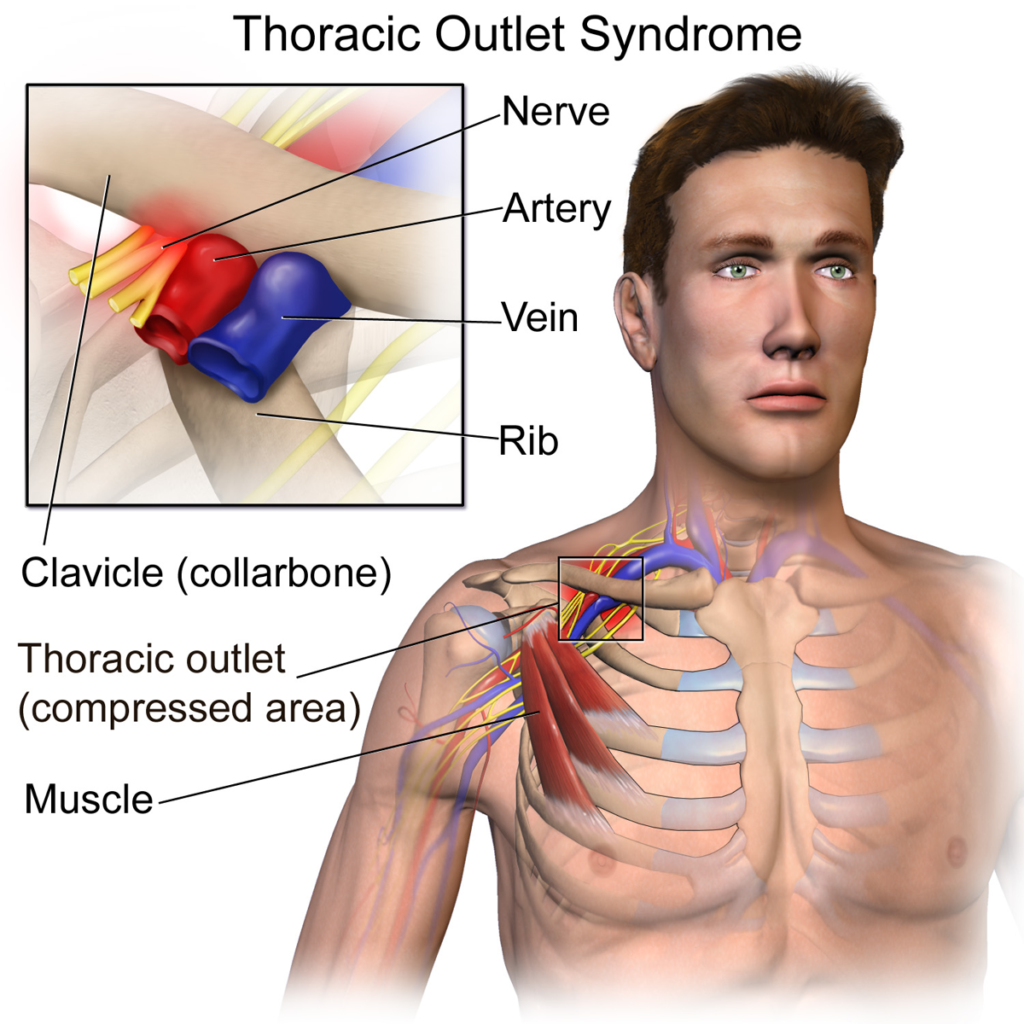Thoracic Outlet Syndrome (TOS) can be a debilitating condition that causes tingling, pain, and numbness in the hands and arms. If you’re experiencing these symptoms, you may be wondering about the causes, symptoms, and treatment options available to you. In this comprehensive guide, we’ll delve into the intricacies of TOS and explore how chiropractic care can help alleviate your symptoms and address the root cause of the condition.
Understanding Thoracic Outlet Syndrome
TOS occurs when the blood vessels or nerves in the space between your collarbone and top rib, known as the thoracic outlet, become compressed. This compression can lead to various symptoms, including pain, numbness, and weakness in the affected areas. While TOS can affect individuals of all ages, it is most commonly observed in adults between 20 and 40 years old who engage in physical activities involving repetitive overhead arm use or heavy lifting.
Causes of Thoracic Outlet Syndrome
TOS can be caused by the compression of two different structures: the brachial plexus and the blood vessels of the upper back and neck.
Brachial Plexus Compression: The brachial plexus is a bundle of nerves located in the front of the neck, shoulders, and chest. Compression of the brachial plexus can occur due to factors such as the collarbone, surrounding muscles, or the presence of a cervical rib—an extra rib that some individuals are born with.
Blood Vessel Compression: TOS can also involve compression of the blood vessels in the upper back and neck region. This compression can result in additional symptoms such as swelling, color changes, coldness in the hands and arms, and the appearance of black spots under the fingernails caused by burst blood vessels.
Symptoms of Thoracic Outlet Syndrome
The symptoms associated with TOS can vary from person to person, as both nerve and blood vessel compression can contribute to the condition. However, common symptoms include:
- Tingling or pins and needles sensation in the hands and arms
- Dull to severe pain in the hand, arm, shoulder, and/or neck
- Arm weakness
- Numbness in the hands and fingers, particularly in the ring and pinky fingers
- Difficulty in grasping objects
Diagnosing Thoracic Outlet Syndrome
Diagnosing TOS can be challenging due to the wide range of symptoms associated with the condition. It is often mistaken for carpal tunnel syndrome, a different condition altogether. Recent research indicates that neural compression is responsible for symptoms in approximately 90% of individuals diagnosed with TOS.
If you suspect that you may be suffering from TOS, it is crucial to seek professional medical advice. A chiropractor can play a vital role in diagnosing TOS by conducting a thorough examination and evaluating your symptoms, medical history, and lifestyle factors.
Treatment Options for Thoracic Outlet Syndrome
Chiropractors specialize in providing comprehensive care for musculoskeletal conditions, including TOS. Once diagnosed, they employ various interventions to alleviate symptoms and treat the underlying cause of the compression.
Chiropractic Interventions for TOS
Chiropractic treatment for TOS often includes a combination of the following techniques:
Thoracic Spinal Adjustments: Chiropractors perform targeted adjustments to the upper back (thoracic spine) to restore proper alignment and function. These adjustments aim to alleviate pressure on the affected nerves and blood vessels.
Stretching and Exercise: Specific stretching exercises can help improve flexibility and strengthen the muscles surrounding the thoracic outlet, reducing compression and relieving symptoms.
Manual Trigger Point Therapy and Myofascial Release: Chiropractors employ these techniques to locate tender trigger points in the affected muscles and apply pressure using fingers or specialized instruments. This pressure helps release tension, soften trigger points, and ultimately reduce pain and discomfort.
Lifestyle Modifications for TOS Management
In addition to chiropractic interventions, lifestyle modifications are essential for the successful management and recovery from TOS. Your chiropractor may recommend the following changes:
- Avoid Heavy Loads: Carrying heavy loads and putting excessive pressure on the shoulders should be avoided whenever possible. This includes items like briefcases, laptop cases, and heavy shoulder bags.
By adopting these lifestyle modifications, you can minimize stress on the affected area and promote healing.
The Benefits of Chiropractic Care for Thoracic Outlet Syndrome
Chiropractic care offers several benefits to individuals suffering from TOS. The key advantages of seeking chiropractic treatment include:
Restoring Joint Balance: Chiropractic adjustments help restore balance to the joints of the spine, particularly those in the neck. This improved alignment can alleviate pressure on the brachial plexus and surrounding structures, reducing symptoms.
Addressing Muscular Imbalances: Chiropractic care focuses on addressing muscular imbalances in the shoulders, back, and scalenes (deep neck muscles). By targeting these areas, chiropractors can relieve tension and promote optimal muscle function.
Case Study Results: A case study conducted on a 60-year-old man who had been suffering from TOS for seven years without prior treatment demonstrated the potential of chiropractic care. After just one chiropractic visit involving spinal adjustments to the first cervical vertebra (the atlas), the patient reported a reduction in symptoms. This finding emphasizes the effectiveness of chiropractic interventions in managing TOS.
Conclusion
Thoracic Outlet Syndrome can significantly impact your daily life, causing discomfort and limiting your ability to perform routine tasks. By understanding the causes, symptoms, and treatment options available, you can take the necessary steps toward relief and recovery.
Chiropractic care offers a holistic approach to TOS treatment, focusing on alleviating symptoms, addressing the root cause of compression, and promoting overall musculoskeletal health. By consulting with a chiropractor and undergoing the recommended interventions, you can regain balance, reduce pain, and enhance your quality of life.
Remember, seeking professional medical advice is essential if you suspect you have TOS. A chiropractor will provide a tailored treatment plan based on your individual needs, helping you overcome the challenges posed by Thoracic Outlet Syndrome.



